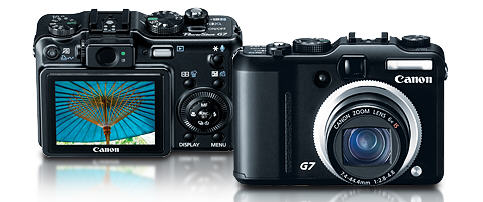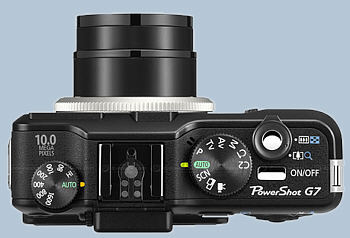

Canon Powershot G7
![]()
Canon's new Powershot G7 replaces the earlier G6 and features a 10MP sensor, a 6x optically stabilized zoom (35-210mm equivalent), ISO 1600 (with a dedicated ISO dial) and Canon's new Digic III chip. The existence of the Digic III was inadvertently revealed in another press release last month and there was some speculation it would first be used in a new 1D series DSLR, but it has in fact made its first appearance in the new Powershot G7.

Those hoping for RAW support will be disappointed since the Canon Powershot G7 only supports JPEGs. It seems that Canon now only intend to offer RAW support on DSLRs. Hot shoe support for external speedlites is provided though. Like most new digicams and many new DSLRs, the Canon Powershot G7 now used SD memory cards.
The price of the Canon Powershot G7 is currently around $530. In comparison, when it came out in 2004, the G6 had a selling price of $699.
Overall the G7 represents a significant advance over the G6, except for the lack of the RAW format option. Below is a summary of the significant differences:
| Powershot G7 | Powershot G6 |
| 10 MP sensor | 7 MP sensor |
| 6x zoom (35-210mm) | 4x zoom (35-140mm) |
| Optical Stabilizatiom | No Optical Stabilization |
| ISO 80-1600 | ISO 50-400 |
| 2.5" fixed LCD | 2" swing-out LCD |
| SD memory card | CF memory card |
Both cameras feature a wide range of user controllable options, such as Shutter Priority, Aperture Priority and fully manual exposure modes as well as several fully automatic programs

![]()
Here's a copy of Canon's Press Release
14 September, 2006: Canon today launches the eagerly awaited PowerShot G7. Following the celebrated PowerShot G6, the classically styled PowerShot G7 boasts an advanced feature set that includes 10.0 Megapixel resolution, a 6x optically image stabilised zoom lens and Canon's new DIGIC III image processor.
DIGIC III delivers rapid performance with improved image quality and incorporates two
new Canon technologies - Face Detection AF/AE and advanced Noise Reduction, which extend
the camera's low-noise performance to ISO 1600. The high-resolution 2.5” LCD screen
has a wide viewing angle and anti-glare coating for easier image framing and playback.
Furthering the potential for creative photography, the PowerShot G7 is equipped with hot
shoe support for Canon Speedlite flash units and is compatible with a range of optional
converter lenses.
PowerShot G7 will be available from early October.
The PowerShot G7 features:
- 10.0 Megapixels
- 6x optical zoom lens with optical Image Stabilizer and SR coating
- DIGIC III and iSAPS with Advanced Noise Reduction and Face Detection AF/AE
- 2.5” high-resolution LCD with wide viewing angle and anti-glare coating
- ISO 1600 for flash-free, low light shooting
- Ergonomic design with dedicated ISO and Multi Control dials for fast, easy operation
- 25 shooting modes including full manual control and 2 custom settings
- Extra telephoto reach with Digital Tele-Converter and Safety Zoom
- Hot shoe support for Canon Speedlite flashes and optional lens accessories
“The PowerShot G7 brings a new level of performance and usability to the G series,” said Mogens Jensen, Head of Canon Consumer Imaging Europe. “By introducing our DIGIC III image processor and new technologies such as Face Detection AF/AE, Canon continues to raise the benchmark for digital compact cameras."
Image Quality and Optics
The PowerShot G7 delivers the image quality and optical performance demanded by
advanced photographers. A 10.0 Megapixel sensor captures enough fine detail to ensure
large photo quality prints with added cropping flexibility. The fast f/2.8 (W) –
f/4.8 (T) 6x optical zoom lens (35-210mm focal length, 35mm equivalent) incorporates
optical Image Stabilizer technology to counteract the effects of camera shake, allowing
the camera to be used at slower shutter speeds in low light conditions. The lens
configuration consists of 9 elements in 7 groups and includes a double-sided aspherical
lens element to counteract common lens distortions. The addition of Canon’s SR lens
coating – a first for Canon's digital compact camera range – significantly
reduces the problem of ghosting and virtually eliminates chromatic aberration.
DIGIC III
Canon’s new DIGIC III image processor drives improved responsiveness and colour rendering along with increased noise reduction, extending the camera's ISO range to ISO 1600. A dedicated ISO dial makes it simple to switch between settings. Complementing DIGIC III's performance, the camera features the same DDR-SDRAM used in professional EOS cameras – raising the data throughput rate substantially.
Face Detection AF/AE
For portrait and group shots, the PowerShot G7 is equipped with Face Detection AF/AE, a
new Canon technology that automatically detects up to nine faces within a frame and sets
the optimum focus and exposure accordingly. If there is more than one face in a frame Face
Detection AF/AE is able to determine the face or faces intended to be the main focus. The
system operates at the same speed as Canon’s established 9-point AiAF system, which
it automatically reverts to if no face detection is required or intended.
Designed for photographers
Referencing classic rangefinder cameras, the ergonomic design features analogue inspired
controls, a multi-control dial and a customisable shortcut button for faster access to
camera settings. Usability is further enhanced with a high resolution (207,000 pixels)
2.5" LCD. The low-reflection screen coating aids visibility in sunny conditions while
a wide viewing angle helps with group viewing or and aids more creative framing options.
A selection of 25 shooting modes includes full Manual and two custom settings, enabling
users to tailor the camera to their specific preferences. Shooting modes are complemented
by advanced settings such as AEB (auto exposure bracketing), focus bracketing, and an
integrated neutral density (ND) filter with 3 stops adjustment. Photographers can also
take advantage of second curtain flash synchronisation for creative flash exposures, while
interval shooting (up to 100 shots in 1-60 minute increments) allows for extended
time-lapse photography of up to four days.
Advanced movie functions include high resolution XGA (1024 x 768 pixels) video capture
with sound at 15fps. Users can also record VGA and QVGA movies at a smooth 30fps.
A new Safety Zoom feature allows users to extend the camera's zoom range without interpolation affecting image quality. Images can be captured at up to 14x zoom with enough resolution for lab-quality postcard (10 x 15cm) prints. Photographers can also enable the Digital Tele-Converter3 feature for added telephoto reach on every shot, without the reduction in aperture typically caused by optical tele-converters.
Accessories
In addition to Canon Speedlite support, the PowerShot G7 is compatible with a range of
optional lens accessories, including wide (0.75x) and tele (2.0x) converter lenses. A
waterproof case allows for shooting at depths of up to 40 metres.
Additional Information
Printing
Full PictBridge support means users can print directly to any PictBridge compatible
printer without the need for a PC. A Print/Share button allows one-touch printing and easy
uploads to Windows or Mac systems.
Additions to the PictBridge functionality include contact sheet printing with 35 images on one A4 page and 20 image index prints with shooting information, allowing the user to compare images with the settings used to take them.
Memory Card Support
In addition to SD and MMC memory cards, the PowerShot G7 supports the new SDHC format for
storage capacities of 2GB and upwards. The camera comes supplied with a 32MB memory card.
Software
The PowerShot G7 comes bundled with the following Canon Software:
- ZoomBrowser EX 5.7 (Windows), ImageBrowser 5.7 (Mac): For organizing and editing images, movies and slideshows, or creating and printing digital photo albums.
- PhotoStitch 3.1: For creating panoramic photos from multiple images (Windows and Mac).
Accessories
- Speedlite 220EX/ 430EX/ 580EX
- Tele-converter (2.0x) TC-DC58C
- Wide-converter (0.75x) WC-DC58B
- Lens adapter/Hood set LA-DC58H
- Waterproof Case WP-DC11
- Waterproof Case Weight WW-DC1
- Soft Case DCC-600
- High Power Flash HF-DC1
- AC Adapter Kit ACK-DC20
- Rechargeable Li-ION battery pack NB-2LH
- Car Battery Charger CBC-NB2
Technologies Explained
DIGIC III
Canon’s DIGIC III (DIGital Imaging Core) image processor manages all of the
camera’s primary functions to optimize operating efficiency. Advanced image
processing algorithms deliver superb image detail and colour reproduction with accurate
white balance. Key improvements over DIGIC II include markedly faster response times,
advanced Noise Reduction Technology and support for Canon's Face Detection AF/AE
technology. DIGIC III also enables the PowerShot G7 to support DDR-SDRAM, effectively
doubling data throughput rates for even faster performance.
Optical Image Stabilizer
The PowerShot G7 uses a lens shift-type Image Stabilizer (IS) system to detect and correct
slight camera shakes that can cause image blur. Minute vibration gyros detect lens tilting
caused by hand shake. These signals – up to 4,000 per second – are processed by
a single-chip IS controller, which discriminates between hand shake and intentional camera
movements. Shake signals are sent to the IS unit, which moves one of the lens elements
accordingly to deflect the light rays and cancel out the effects of shake. For improved
accuracy and responsiveness, the moving lens element is supported on tiny ceramic spheres.
In addition to minimising friction, ceramic spheres avoid some of the problems that can
affect metal spheres, such as thermal expansion and magnetism. The PowerShot G7's optical
IS allows photographers to shoot at shutter speeds up to 3 stops slower with no
perceptible increase in image blur.
Face Detection AF/AE
Canon’s Face Detection AF/AE system automatically detects up to nine faces within a
frame before adjusting the focus and exposure accordingly to ensure optimal results. It is
able to determine which faces are intended to be the focus, while at the same time it can
recognize and immediately revert to the partnering 9-point AiAF system if no face is
intended to be the focus.
SR Coating
The SR (Small Radius) coating is used on lenses containing elements that have a
significantly smaller radius on the back surface of the lens than on the front surface.
The coating is optimised for small radii and is designed to maintain the highest
resolution and colour fidelity possible by dramatically reducing ghosting and flare, while
virtually eliminating chromatic aberration.
Digital Tele-Converter and Safety Zoom
Similar to placing an accessory lens on the front of the camera, Canon’s Digital
Tele-Converter adds a constant digital zoom to every shot (1.4x / 2.3x). While optical
converter lenses cause a reduction in aperture and consequently require a slower shutter
speed, the Digital Tele-Converter maintains aperture size, reducing the risk of image
blur.
Safety Zoom protects the image from interpolation at high levels of digital zoom, allowing
users to extend zoom magnification without sacrificing image quality.
